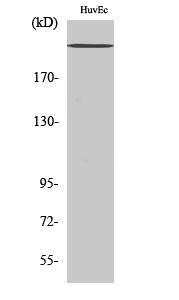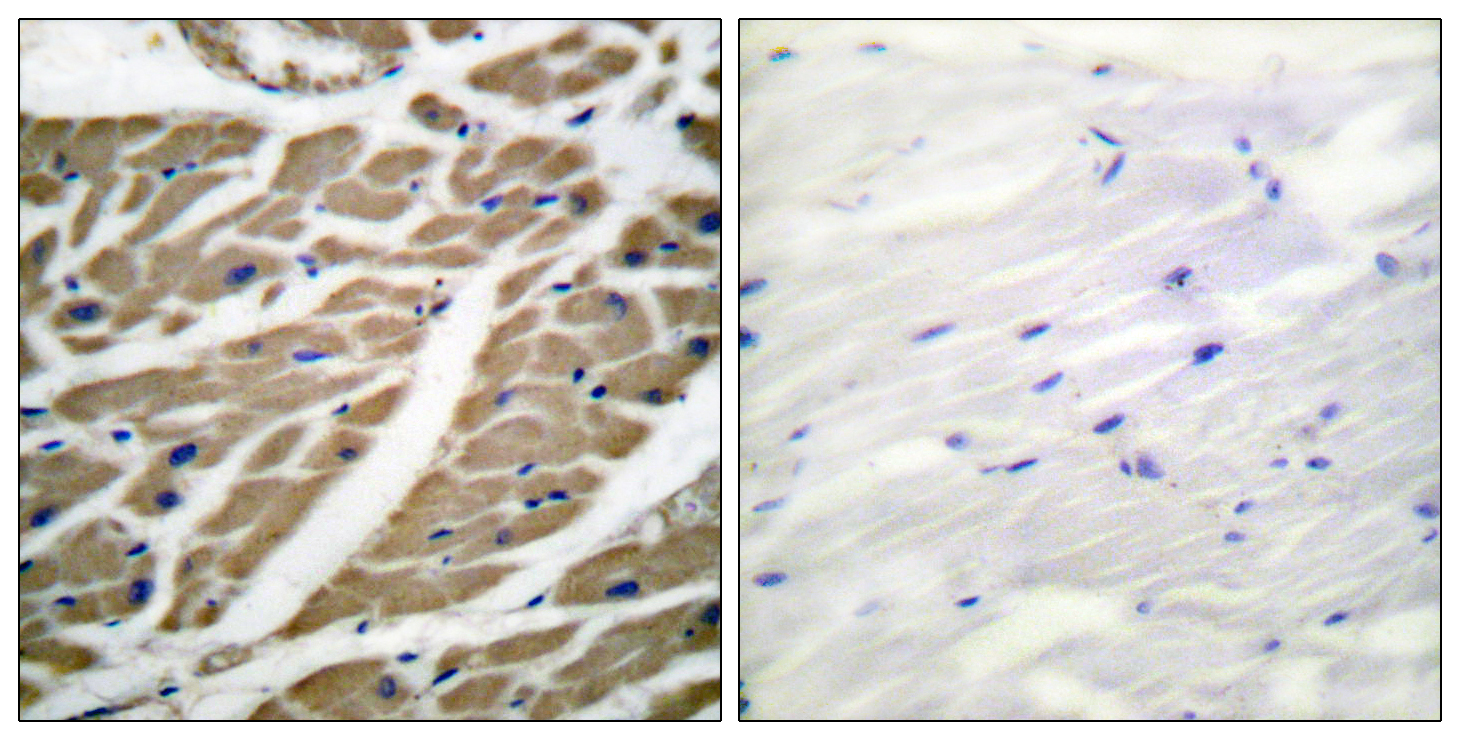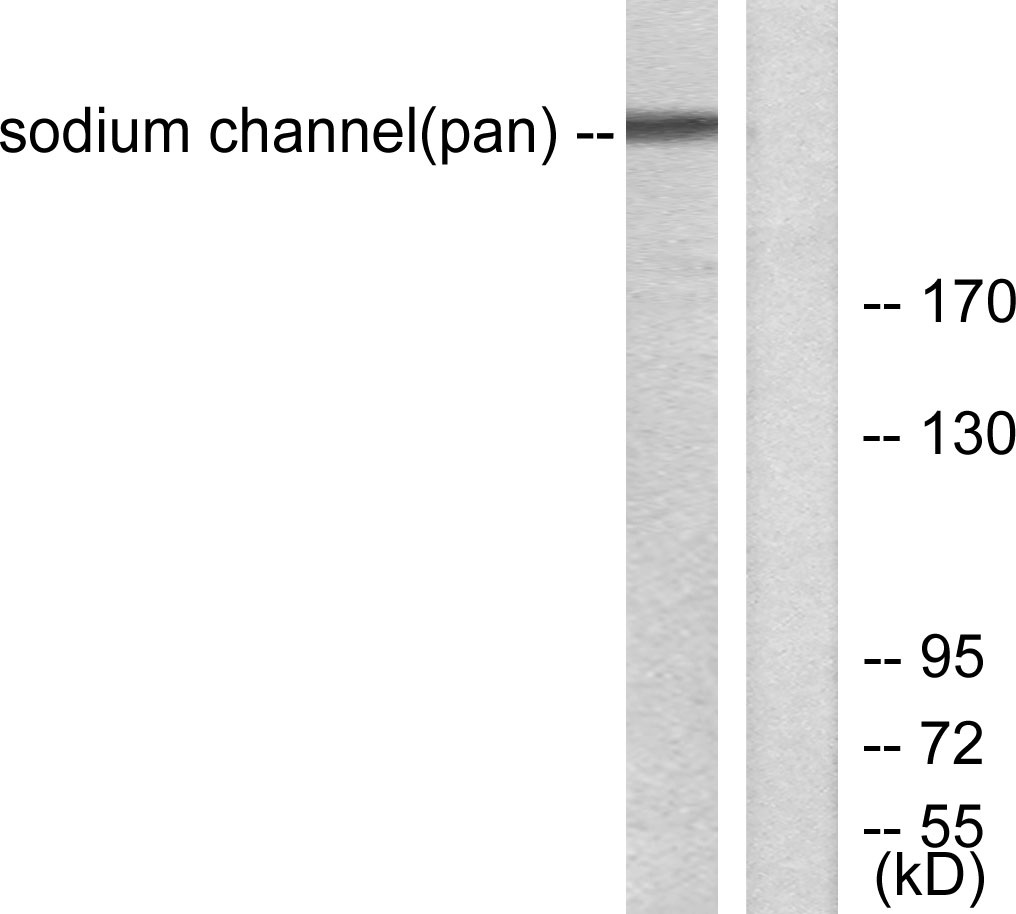Na+ CP-pan Polyclonal Antibody
- Catalog No.:YT2970
- Applications:WB;IHC;IF;ELISA
- Reactivity:Human;Mouse;Rat
- Target:
- Na+ CP-pan
- Fields:
- >>Dopaminergic synapse
- Gene Name:
- SCN1A/SCN2A/SCN3A/SCN4A/SCN5A/SCN8A/SCN9A/SCN10A/SCN11A
- Protein Name:
- Sodium channel protein type 1 subunit alpha
- Human Gene Id:
- 6323/6326/6328/6329/6331/6334/6335/6336/11280
- Human Swiss Prot No:
- P35498/Q99250/Q9NY46/P35499/Q14524/Q9UQD0/Q15858/Q9Y5Y9/Q9UI33
- Mouse Gene Id:
- 110880
- Rat Gene Id:
- 81574/24766/497770/25722
- Rat Swiss Prot No:
- P04774/P04775/P08104/P15390
- Immunogen:
- The antiserum was produced against synthesized peptide derived from human Sodium Channel. AA range:1466-1515
- Specificity:
- Na+ CP-pan Polyclonal Antibody detects endogenous levels of Na+ CP-pan protein.
- Formulation:
- Liquid in PBS containing 50% glycerol, 0.5% BSA and 0.02% sodium azide.
- Source:
- Polyclonal, Rabbit,IgG
- Dilution:
- WB 1:500 - 1:2000. IHC 1:100 - 1:300. IF 1:200 - 1:1000. ELISA: 1:20000. Not yet tested in other applications.
- Purification:
- The antibody was affinity-purified from rabbit antiserum by affinity-chromatography using epitope-specific immunogen.
- Concentration:
- 1 mg/ml
- Storage Stability:
- -15°C to -25°C/1 year(Do not lower than -25°C)
- Other Name:
- SCN1A;NAC1;SCN1;Sodium channel protein type 1 subunit alpha;Sodium channel protein brain I subunit alpha;Sodium channel protein type I subunit alpha;Voltage-gated sodium channel subunit alpha Nav1.1;SCN2A;NAC2;SCN2A1;SCN2A2;Sodiu
- Observed Band(KD):
- 230kD
- Background:
- Voltage-dependent sodium channels are heteromeric complexes that regulate sodium exchange between intracellular and extracellular spaces and are essential for the generation and propagation of action potentials in muscle cells and neurons. Each sodium channel is composed of a large pore-forming, glycosylated alpha subunit and two smaller beta subunits. This gene encodes a sodium channel alpha subunit, which has four homologous domains, each of which contains six transmembrane regions. Allelic variants of this gene are associated with generalized epilepsy with febrile seizures and epileptic encephalopathy. Alternative splicing results in multiple transcript variants. The RefSeq Project has decided to create four representative RefSeq records. Three of the transcript variants are supported by experimental evidence and the fourth contains alternate 5' untranslated exons, th
- Function:
- disease:Defects in SCN1A are a cause of intractable childhood epilepsy with generalized tonic-clonic seizures (ICEGTC) [MIM:607208]. ICEGTC is a disorder characterized by generalized tonic-clonic seizures beginning usually in infancy and induced by fever. Seizures are associated with subsequent mental decline, as well as ataxia or hypotonia. ICEGTC is similar to SMEI, except for the absence of myoclonic seizures.,disease:Defects in SCN1A are a cause of severe myoclonic epilepsy in infancy (SMEI) [MIM:607208]; also called Dravet syndrome. SMEI is a rare disorder characterized by generalized tonic, clonic, and tonic-clonic seizures that are initially induced by fever and begin during the first year of life. Later, patients also manifest other seizure types, including absence, myoclonic, and simple and complex partial seizures. Psychomotor development delay is observed around the second yea
- Subcellular Location:
- Cell membrane ; Multi-pass membrane protein .
- Expression:
- Brain,Normal brain,
- June 19-2018
- WESTERN IMMUNOBLOTTING PROTOCOL
- June 19-2018
- IMMUNOHISTOCHEMISTRY-PARAFFIN PROTOCOL
- June 19-2018
- IMMUNOFLUORESCENCE PROTOCOL
- September 08-2020
- FLOW-CYTOMEYRT-PROTOCOL
- May 20-2022
- Cell-Based ELISA│解您多样本WB检测之困扰
- July 13-2018
- CELL-BASED-ELISA-PROTOCOL-FOR-ACETYL-PROTEIN
- July 13-2018
- CELL-BASED-ELISA-PROTOCOL-FOR-PHOSPHO-PROTEIN
- July 13-2018
- Antibody-FAQs
- Products Images

- Western Blot analysis of various cells using Na+ CP-pan Polyclonal Antibody diluted at 1:1000

- Immunohistochemistry analysis of paraffin-embedded human heart tissue, using Sodium Channel-pan Antibody. The picture on the right is blocked with the synthesized peptide.

- Western blot analysis of lysates from HUVEC cells, using Sodium Channel-pan Antibody. The lane on the right is blocked with the synthesized peptide.



